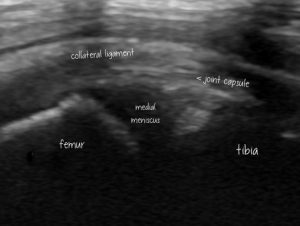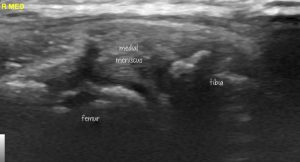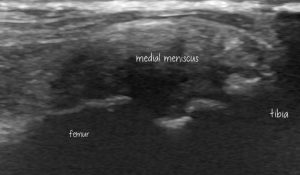Meniscal extrusion in dogs: the sonographic perspective
Ultrasound is great for rheumatology generally and will yield useful information in many dogs with stifle injuries. I wanted to post some images of menisci because it’s been a voyage of discovery working out how what we see relates to what surgeons see on arthroscopy or arthrotomy, how to report these changes and what the likely implications are for prognosis and treatment.
The most dramatic change in many dogs with significant medial meniscal injury is extrusion of meniscal material medially.

A healthy canine medial meniscus in longitudinal plane. The lateral boundary of the meniscus is smooth, regular and does not extend beyond the medial limits of the tibio-femoral compartment.

The same view in a lame dog with medial extrusion of the medial meniscus. The meniscus bulges beyond the limits of the femoral and tibia cortices. The meniscal substance is also abnormally heterogeneous

Another extruded meniscus
I’ll try to add some better images in time. To be honest, I’d like to maintain the impression that sonographic skill is required but this is pretty straightforward and obvious in most cases.
Meniscal extrusion is not something that’s much discussed in the veterinary literature and surgeons may look at you blankly when you tell them that you’ve seen this. They generally want to know if there’s a tear. Extrusion is not something that’s readily apparent at arthrotomy. when the femoral aspect of the meniscus is inspected.
However, in human medicine, extrusion is better documented and understood.
https://radiopaedia.org/articles/meniscal-extrusion
Furthermore, the effect of meniscal extrusion on knee biomechanics has been investigated.
https://arthritis-research.biomedcentral.com/articles/10.1186/s13075-015-0579-4
Extrusion occurs with a loss of meniscal ‘hoop tension’ due to tears: especially tears of the caudal root of the medial meniscus.
Unsurprisingly, when half the meniscus has splurged out of the joint space, there’s a marked change in femur-to-tibia force transmission which results in accelerated osteoarthritis. In practice, the changes which we can see on ultrasound are often a better indication of the functional state of the meniscus than simply knowing whether there is a tear.
In the human sphere, surgical techniques have evolved towards addressing the functional problem by repairing these root tears. I struggled to find any reference to meniscal root tears in the canine literature. From discussion with colleagues (acknowledgement and thanks to Bob Pettit) this appears to be a frontier of investigation.
As I understand it, the evidence base in canine medicine does not currently give us a lot of help when trying to decide how to address meniscal injuries. To quote McCready and Ness:
J Small Anim Pract 2016 Apr;57(4):194-204
Systematic review of the prevalence, risk factors, diagnosis and management of meniscal injury in dogs: Part 2
D J McCready, M G Ness
https://pubmed.ncbi.nlm.nih.gov/27000649/
‘Conclusions: Despite a large number of publications the quality of evidence was generally low. No one study or combination of studies provided high quality evidence to support one diagnostic or surgical intervention over another for meniscal injuries in dogs with cranial cruciate ligament failure.’





